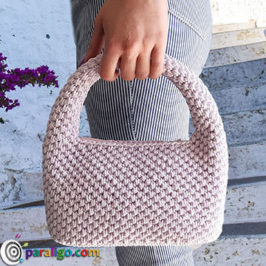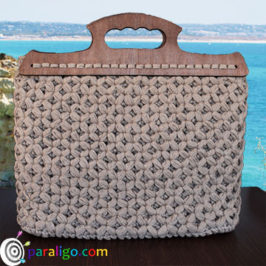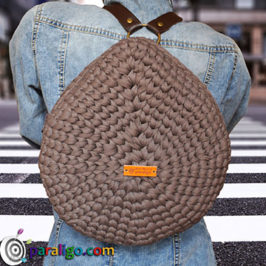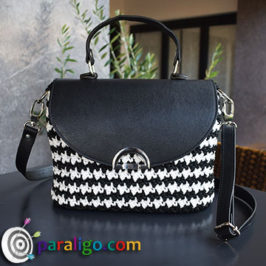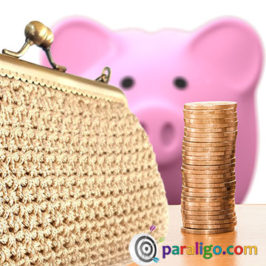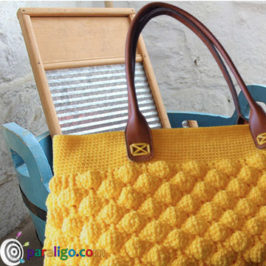
Today we are talking about the use of Macrame Cord for crochet, which is the number three listing in my catalog that answers the following question:
What type of yarn is best for bags?
This post is the third part of a series of articles, intended to guide crocheters and especially those who crochet bags through the challenging world of crochet materials. The first chapter of this guide was about T shirt yarn and the second was dedicated to Ribbon yarn. If you missed them you can click on the above links (colored text) to catch up.
To be quite honest, the only reason why macramé cord is not the number one entry in my list would be availability. In many parts of the world including Northern Europe and the US, crocheters have a quite hard time finding craft cords, especially synthetic ones. This is usually because they are strictly marketed as macramé cords and rarely as crochet cords/yarns.

Where I live, in Greece, macramé cord is called Bag yarn and it is definitely the number one choice for crochet bags. So can you use a macramé cord to crochet? Yes, you can and you absolutely must…because macramé cord is an excellent choice for crochet jewelry, crochet bags, coin purses, hats, baskets, rugs, ottomans, and of course wall art.
What is known as Macrame Cord includes a great variety of fibers that are both braided or plied. They can initially be divided into two categories: such as cotton, twine, linen, hemp, jute, raffia, paper, or even leather and artificial fiber cords such as polyester/polyamide (nylon, dacron, etc) and olefins (polypropylene).There is also a wide range of variation in sizes from usually 2mm to 12mm and an amazing assortment of different colors, textures, and looks, especially for artificial fiber cords. From matt and organic to gloss and glitter the certain thing is that you will never get bored with craft cords.

 Ice Yarns MACRAME CORD 100% Polyester. Price: $4.99 4 x 100gr Skeins Click to get it on Amazon!
Ice Yarns MACRAME CORD 100% Polyester. Price: $4.99 4 x 100gr Skeins Click to get it on Amazon!Craft cords may come in large or small rolls, skeins, hanks, or cones. The diameter of macrame cords is usually indicated in millimeters (mm). Weight depends on the composition of the fiber. A 4mm cotton cord can weigh 7.8 oz (220 g.) per 54 yards (50m) whereas a 3mm polyester cord weighs about 90 g per 130 m and a 3mm paper twine skein weighs 10.5 oz (300g) per 260 yards / (240m).
Pros
- Light: Though certain natural fiber cords can be relatively heavy, craft cords are usually very lightweight, a feature that is essential for creating crochet bags.
- Easy: As a rule macramé cords are smooth (some plant fibers excepted) and sleek, especially artificial ones. This means zero friction when pulling loops which is definitely an advantage in crochet.
- Stiff or Soft: Depending on their composition, diameter, and density, craft/macrame cords; like thick cotton cords or lurex cords can be stiff enough to hold their form in projects where desired, such as the Wristlet Purse or the Pyramid Crochet Clutch. In contrast, a thin plain polyester cord can be delightfully soft and easy to work with causing only minimal strain for your hands and if necessary it can always be reinforced with plastic canvas or a similar material.
- Uniform: Cords are flawless; again except for some plant fibers which tend to have a more natural organic feel and look, most of the types of craft cords can produce beautiful, even, handiwork.
- Elegant: The variety of color, texture, and thickness offers an almost boundless possibility to design and produce amazingly stylish and sophisticated items.
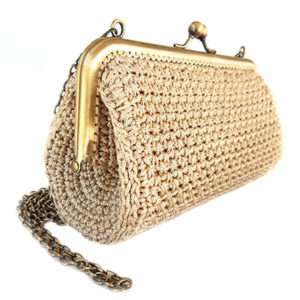 Cons:
Cons:
- Expensive: The small diameter of these cords that are usually preferred for crochet (very thick cords are seriously not recommended), result in larger quantities, which means higher budgets required per project. Also, some types of natural fiber are, by definition, expensive.
- Slow: The recommended thinner diameter of this type of yarn results in more stitches, rounds, and rows and consequently take more time to complete a project. I must note though that there are exceptions of highly recommended chunky cords for which the above-mentioned do not apply.
- Frays: Just to make a decent effort to find more disadvantages (so that you won’t think I m biased) I will state that the ends of mainly synthetic cords tend to fray.
Tips
- Some matt polyester and polyamide cords tend to produce more friction than glossy ones. Also, Jute and metallic cords can be rough, therefore when choosing your supplies take into consideration what kind of stitch you intend to use. If your pattern involves long loops and complicated stitches a glossy cord or, if you prefer a matt look a soft cotton cord, would be the best choice.

Before beginning a project make sure to treat the ends of a cord to prevent fraying. You can burn the ends of polyester and polyamide cords or sew natural fiber cords if you must.
Dos
- Cords are ideal for projects where elements such as a bow or a crochet flower come to decorate your design, rather than /a stitch /in the work itself.
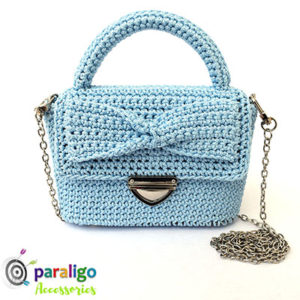
- If you are eager to use rich voluminous stitches such as the Balloon stitch, bobble stitch, candy stitch, shell stitch, fan stitch, etc, a thin macramé cord is a perfect yarn to do it.
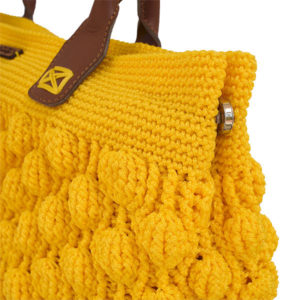
- You will be amazed at how good simple stitch patterns such as the lemon peel stitch, grit stitch, Suzette stitch or even a plain single crochet pattern look when worked with thin macramé cords.
- You must absolutely try plant fiber cord to create summer bags for the beach or the city. Cotton, jute, and raffia cords combined with stitches that produce woven like looks, such as the spike stitch, or the herringbone stitch are simply fabulous!
Don’ts
- I wouldn’t recommend the use of vertical and long loop stitches such as the zigzag puff stitch, Canestro stitch, or the Rattan stitch with thin cords. The outcome will be disappointing. If you want to take advantage of the lightweight feature of cords for those stitches, definitely use a chunky polyester cord.
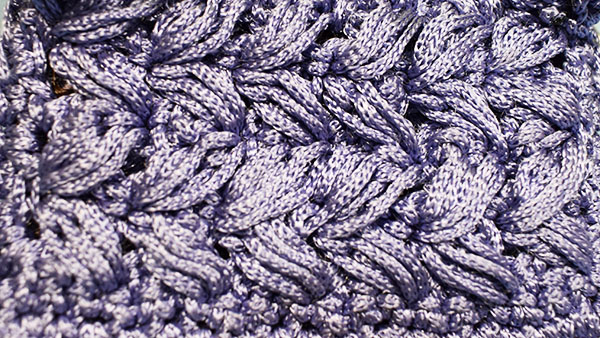
- Avoid long looped and complicated stitches when using sticky matt polyester or polyamide cords, jute twine, rough hemp, or metallic cords. If you insist on using a cord for your project, preferably choose a thick, glossy polyester cord.
- It’s not a good idea to work on a big project, such as a large shopping bag using thin cords such as a 2 or 3mm polyester cord. Your bag will literarily take ages to finish and several skeins of yarn and I am sure as you have already noticed these don’t come for free.


